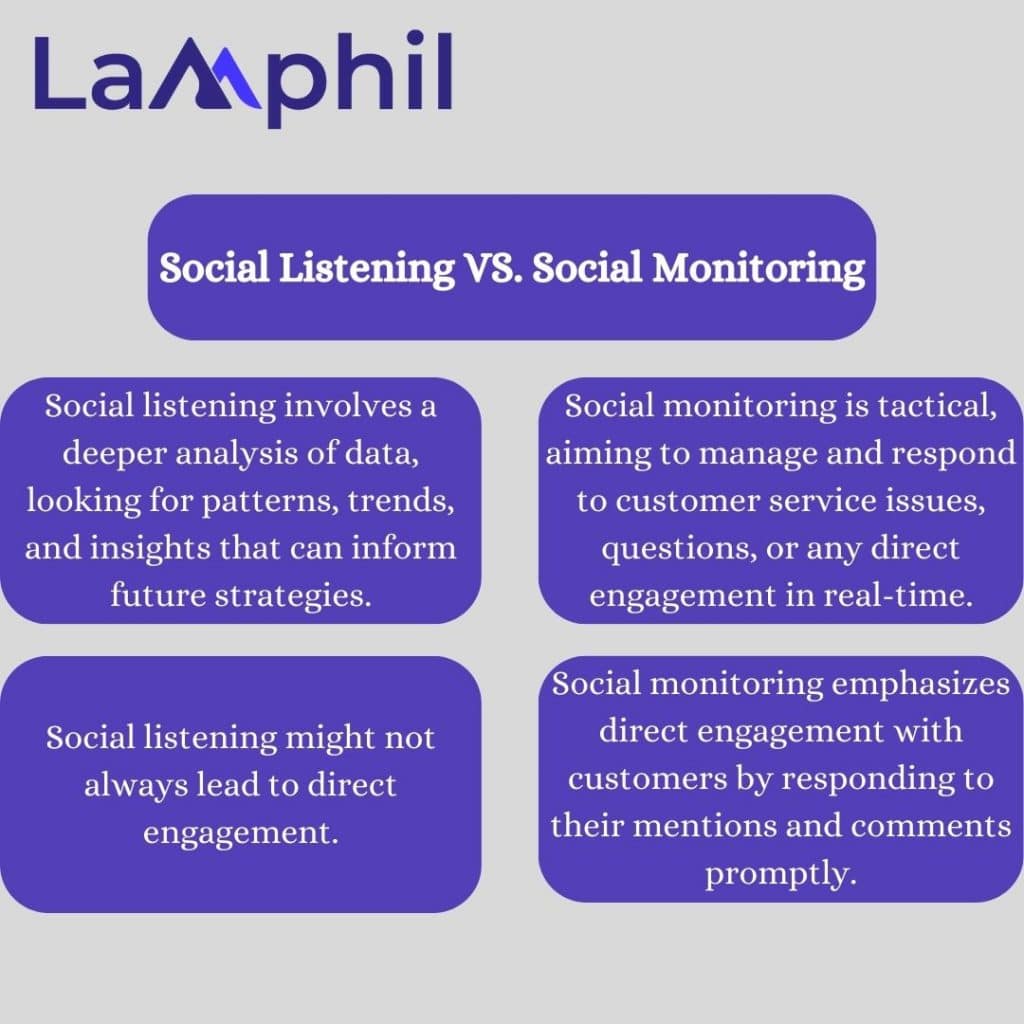Have you ever wondered what the difference is between social listening and social monitoring in digital marketing? It’s a crucial distinction, and understanding it can significantly impact how you engage with your audience and refine your marketing strategies. I’m going to show you how to use both social monitoring and social listening. Trust me, combining these approaches can take your digital marketing to the next level. You’ll be able to respond swiftly to your audience while also gaining valuable insights to refine your strategies and better meet your goals. Ready to dive in? Let’s get started!
Key Points
- There is an essential difference between social listening, which involves analyzing conversations to understand market sentiment and improve strategy, and social monitoring, which focuses on responding to mentions and comments.
- Companies engage in social monitoring to respond quickly to customer inquiries, address complaints and issues promptly, and acknowledge positive feedback. This proactive engagement helps maintain a good customer relationship and brand reputation.
- While both social listening and monitoring are vital, they serve different purposes. Monitoring deals with immediate engagements and feedback, whereas listening involves a deeper analysis to inform strategy and understand the broader market sentiment.
Understanding the Difference Between Social Listening and Social Monitoring
When I first started in digital marketing, I focused solely on social monitoring. I thought that quickly responding to mentions and comments was all I needed to manage our brand’s online presence. And don’t get me wrong, it’s important! Social monitoring is great for handling customer inquiries, addressing complaints, and keeping tabs on what’s being said about your brand in real time.
But then I discovered social listening, and it changed everything. Social listening goes beyond just reacting; it’s about understanding the bigger picture. By analyzing conversations and trends, I could see what people really thought about our brand and our competitors. This deeper insight helped us adjust our marketing strategies more effectively.
For instance, through social listening, we realized that a significant portion of our audience was discussing sustainability. We hadn’t focused much on this in our marketing before. Still, by being part of these conversations and understanding their concerns and interests, we were able to develop content and campaigns that resonated more with our audience. This shift not only improved our engagement but also strengthened our brand’s reputation.
What Is the Meaning of Social Monitoring?
Social monitoring involves tracking and responding to social engagements such as user mentions, comments, hashtags, and brand-related keywords. It is an active process that requires brands to monitor everything from positive feedback and reviews to negative feedback and complaints.
Social monitoring requires brands to be vigilant and look for opportunities to engage with their audience. For instance, when a competitor calls out, brands can use the opportunity to intervene and showcase their strengths. Similarly, when people ask for product recommendations, brands can offer their products as a solution. However, such conversations do not always appear in notifications, especially if a brand is active on multiple social media platforms.
To solve this problem, you should use social media monitoring tools to supplement your native data. These tools help brands keep track of many conversations related to their brand, including those that do not directly mention them. Social media monitoring allows your brands to stay on top of their audience’s needs and sentiments and respond promptly to build a positive reputation and improve customer satisfaction.
Why do Companies Engage in Social Monitoring?

Companies use social media not just to promote their products but also to listen. Why do you think they invest time and resources into this? Let’s find out!
#1. For Speedy Customer Inquiries Response
Consider the scenario with an airline. A customer mentions the airline on social media inquiring about the cost of checking an additional bag. Companies attentive to social media monitoring will swiftly provide customers with the necessary cost information and additional details. The customer might have more questions, so it’s important for the representative to offer further assistance if needed.
#2. To Address Complaints and Issues Promptly
Not every question is urgent, but complaints and problems should be resolved quickly to soothe dissatisfied customers and prevent negative feedback from spreading widely online.
For instance, if a customer later expresses dissatisfaction because the airplane’s in-flight Wi-Fi did not work as expected, airlines must proactively resolve such complaints to protect their reputation. Ignoring these complaints is akin to not answering calls at a customer service desk but with the added visibility of social media, where others notice the lack of response.
In such cases, the airline should apologize for any miscommunication and inform the customer about the measures being taken to avoid a recurrence of the problem. Depending on how critical the issue is, the company might consider offering discounts or vouchers to make amends with the dissatisfied customer.
Read: The Top 2024 Brand Mention Tools (All You Need)
#3. To Acknowledge and Appreciate Positive Feedback
Social media isn’t solely a platform for grievances; it’s also where customers share positive experiences with brands. Similar to the earlier scenario, monitoring and recognizing these positive mentions is crucial. Ignoring such positive feedback is equivalent to dismissing a customer’s gratitude without acknowledgment.
Adhering to best practices in social media monitoring, companies should quickly thank the customer, express delight for the opportunity to serve them, and extend an offer to assist further if needed.
What Is the Meaning of Social Listening?

Credit:Freepik
Social listening encompasses a strategic approach to analyzing consumers’ sentiments and viewpoints regarding your industry and competitors. This method is a critical tool for enhancing your brand’s identity by identifying opportunities for growth and potential weaknesses. By pinpointing and understanding pertinent discussions, your organization can proactively address risks and tailor its strategies to more effectively meet customer expectations.
Yet, it’s important to note that this approach requires a more nuanced and detailed analysis compared to simple social media monitoring, which primarily focuses on tracking mentions and keywords. This complexity and the resource-intensive nature of social media listening mean that it remains underutilized by many brands, despite its potential to impact social media audience research significantly.
An illustrative example of social media listening could involve a company in the food and beverage industry tracking online conversations about plant-based diets. By analyzing these discussions, the company could identify a growing trend in consumer preference for plant-based products. This insight could then inform the development of new product lines or marketing strategies aimed at this emerging market segment, thereby aligning the brand more closely with consumer interests and needs.
A Checklist On How To Use Social Media Monitoring Tools To Improve Social Media Strategy
Why Brands Use Social Media Listening
Brands engage in social media listening for several key reasons, all aimed at better understanding and engaging with their audience and market. Let’s break these down into simpler terms and expand on them:
#1. For Tracking Relevant Discussions and Posts
A key motive for implementing social media monitoring is to monitor pertinent conversations and posts and incorporate this data into reports about the audience. It’s essential to also pay attention to how often your competitors and the industry are mentioned, not just when your business is named directly.
The aim is to collect data on your audience, such as:
- Which social media platforms do they use most
- The frequency of mentions your brand gets
- Which competitors are talked about the most
- The level of active discussion within your industry
- Current industry trends
This information aids in understanding your audience and the market better.
#2. For Identifying Improvement Areas and Opportunities
Analyzing the content of mentions, not just their number helps pinpoint areas for improvement and spot opportunities. Look into conversations and content about your brand and sector to grasp what interests your audience. For instance, if a recurrent topic aligns with your business.
If the feedback is favorable, consider applying the successful elements to other business areas. If feedback is negative, acknowledge the issue and apologize for any inconvenience. Recognize this feedback is important to your audience and consider how your company can improve. Negative feedback, though tough, presents a chance to help someone and foster loyalty.
For more insights, look into our guide, “5 Ways Brands Should Handle Negative Feedback on Social Media.”
#3. To Increase Brand Awareness
Social media monitoring also enhances brand visibility. Companies can engage in relevant discussions or trends to market their products or brands through social media monitoring.
You can also identify conversations where your input, even if not directly related to your brand, could be helpful. By offering useful advice, you not only boost brand awareness but also demonstrate your expertise and approachability. This makes customers and prospects more inclined to contact your brand with their queries or concerns.
#4. To Spot Superfans and Influencers
Monitoring allows for the identification of your brand’s superfans and influencers, who are invaluable in amplifying your brand’s message.
Superfans are those who consistently express positive opinions about your brand, recommend your products, and defend your brand during tough times. Influencers are individuals with a significant following that includes your target audience.
Sometimes superfans might also be influencers, but not always. Both play crucial roles in spreading a brand’s message, which is why businesses should use social media monitoring to find these key individuals. Finding influencers and brand advocates is among the ways social media monitoring assists Consumer Packaged Goods (CPG) companies in strengthening their brands.
#5. To Keep an Eye on Competitors
Social media monitoring is a strategic way to stay informed about the public’s opinions on your competitors. By keeping up-to-date, you might avoid their errors, capitalize on their weaknesses, or adopt what people like about them to improve your own success. Review conversations on social media and blogs to get a thorough understanding of how these topics are discussed in relation to your competitors.

What Is the Difference Between Social Listening and Social Monitoring
Distinguishing Between Social Listening and Monitoring:
It’s important to clarify that neither social listening nor monitoring is superior to the other. Rather, recognizing their distinct roles and integrating both approaches can significantly enhance the return on investment (ROI) from your social media marketing efforts.
Micro Compared to Macro Perspectives
Social monitoring zeroes in on individual interactions, where customer service teams actively seek out and respond to customer inquiries, complaints, and comments. This approach involves combing various social media feeds to spot and directly address pertinent notifications.
Conversely, social listening adopts a broader, more holistic perspective, concentrating on the overall perception of your brand and industry. It entails analyzing discussions not only involving your own customers but also those of your competitors and input from industry influencers, offering a comprehensive overview of where your brand stands within the industry context.
In simple terms, social monitoring examines individual trees, while social listening offers a view of the forest as a whole. Although social monitoring is a component of social listening, the latter encompasses a wider range that extends beyond single interactions to provide a full understanding of the brand’s industry status.
Read also: Monitoring Online Content: How To Do This In 5 Steps
Proactive Versus Reactive Approaches
Social listening is characterized by its proactive nature. It involves actively seeking out conversations about your customers and the industry at large with the aim of identifying any gaps or issues. This strategy is focused on uncovering opportunities and addressing problems directly.
The insights gained from social listening are not just for immediate remedies. They can shed light on areas for improvement, such as a feature your product lacks, which could influence future product development. Discoveries about industry-specific tools that could enhance revenue might encourage early adoption to secure a competitive edge.
On the flip side, social monitoring is inherently reactive. It kicks into gear when customers initiate contact through tags, complaints, or suggestions, necessitating a brand’s response.
This is why social monitoring is often included in broader social listening strategies. While monitoring tags is effective for assessing customer sentiment, it’s not the sole method. Both proactive listening and reactive monitoring work together to form a comprehensive strategy for engaging with both customers and the broader industry.
Manual Versus Automated Processes
A clear distinction between “social media monitoring versus social listening” lies in their execution – manual and automated.
Social monitoring might employ tools to aggregate brand mentions or could simply involve manually checking notifications for mentions, requiring hands-on engagement for each response.
In contrast, social listening leverages automation tools tailor-made for this purpose. These tools search for digital discussions, articles, podcasts, videos, and more related to specified keywords and phrases, extending beyond direct brand tags.
Moreover, automated tools are adept at monitoring competitors’ mentions, a task that’s more effectively accomplished via automation. Utilizing the right tools allows for the efficient management and analysis of large data volumes, offering insights that manual monitoring cannot provide.
Differences in Scope and Action
The primary differences between social monitoring and social listening lie in their scope and the actions they necessitate. Social monitoring is narrower and more reactive, focusing on addressing what people say. In contrast, social listening is broader and more proactive, seeking to understand the reasons behind people’s statements. For instance, while social monitoring may assist in resolving a customer’s issue or acknowledging a brand advocate, social listening can unveil new product ideas or uncover market opportunities.
Combine Social Media Monitoring and Listening
When you combine social media monitoring and listening, you completely understand the brand you’re managing for PR.
- Engaging in social media engagement allows for tracking and analyzing discussions related to the brand, its industry, competitors, or key influencers. This facilitates assessing public sentiment and identifying emerging trends.
- Conversely, social media surveillance provides the opportunity to directly interact with stakeholders, such as customers or prospects, aiding in cultivating relationships and establishing trust.
- Merging social media surveillance with engagement captures both the hard numbers and the deeper, qualitative insights into public perception of your client’s brand or the industry at large.
Wrapping up Social Media Monitoring for PR Purposes
The debate isn’t about choosing between social media surveillance and engagement; both methods are crucial for shaping your PR, marketing, and social media tactics. The good news is that there’s no need to pick one over the other when you have access to a tool like Prowly, which encompasses both functionalities and a wealth of other public relations tools.
Simplify Social Media Monitoring and Listening With Lamphils
You can use Lamphils to listen to social media. Our Media Relations service is guided by a comprehensive knowledge of the constantly changing media industry and an extensive network of influential journalists, bloggers, and thought leaders across various platforms. We prioritize building strong, enduring relationships with our clients, based on trust, expertise, and a mutual dedication to producing top-notch, influential content. Contact us
Conclusion
Understanding and effectively utilizing both social monitoring and social listening can significantly enhance your digital marketing strategy. By responding promptly to customer needs and analyzing broader trends, you can improve customer satisfaction and stay ahead of market trends.
Related Post
The Top 2024 Brand Mention Tools (All You Need)
HOW TO MEASURE BRAND AWARENESS: Tips To Improve Your Brand Strategy
Marketing vs. Advertising: Building a Growth Engine for Your Business






